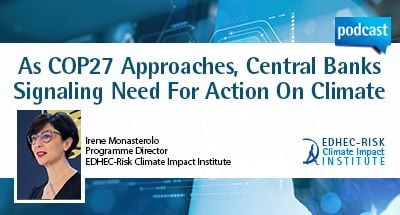
Irene Monasterolo invited to discuss climate stress tests as part of an S&P Global podcast
Written on 12 Oct 2022.

As COP27 Approaches, Central Banks Signaling Need For Action On Climate
Irene Monasterolo, professor of Climate Finance at EDHEC Business School and Programme Director at EDHEC-Risk Climate Impact Institute, was invited by Jennifer Laidlaw, Senior Writer, ESG Thought Leadership at S&P Global Sustainable1, to participate in the ESG Insider podcast series, which explores the environmental, social and governance (ESG) issues that are shaping investor activity and company strategies.
As the urgency to address climate change intensifies, financial regulators and supervisors are taking an increasing interest in climate change and the impact it is having on the financial system and the economy at large. In this episode, to get a better understanding of this landscape, the ESG Insider host looks at some of the recent actions central banks have taken on climate.
In July 2022, the European Central Bank announced plans to incorporate climate change into its monetary policy. Later that month, they announced the results of a climate stress test on the European banking sector.
To find out more about what central banks are doing in the run up to Cop 27, Jennifer turns to Irene. What kind of announcements can we expect in the coming weeks? And during Cop 27? Answers in the episode below.
Below are some of the key points shared by Professor Monasterolo during the episode:
Publication of the third version of the Network for Greening the Financial System climate scenarios has been a big event already in preparation of Cop 27, meaning that both investors, central banks and financial supervisors will use these new scenarios in their next climate stress test exercises. However, what I would really like to hear more is about not only climate finance in terms of mitigation, but also climate finance in terms of adaptation. This has been so far out of the radar and actually attracted still limited attention, but investing in building resilience to climate change is complementary to investing in mitigation.
I think that another important point to cover and that started to be discussed yet at the level of theory, but in practice and in modeling practice in particular, has not received enough attention yet is the assessment of the double materiality of climate risk.
It's really important to grasp both feedback loops in the same metrological framework when we want on the one end to assess risk, but also the opportunities and in particular when we want to analyze under which conditions in terms of designed policies, green financial policies and initiatives could actually affect investors’ response to climate change and their internalization and support or hinder the transition.
“This is the big elephant in the room because so far, for instance in the European Union there was the publication of the taxonomy, European taxonomy of sustainable activities which should at least at the beginning help to identify which activity could be defined as sustainable in the economy. But we don't have yet a classification of activities that could become carbon stranded assets. And yet we know that these activities are the activities that could bring the largest risk both to the economy and finance.
You can access Irene’s latest research (mentioned during the podcast), published in the 2022 special issue of The Journal of Portfolio Management on Novel Risks entitled "Sustainable Investing and Climate Transition Risk: A Portfolio Rebalancing Approach", where she studied how greenness can be combined with other investment criteria to construct sets of corporate bond portfolios with decreasing exposure to climate transition risk.

